
May 2022
Issue 53
Spring is here! Are you ready to get out and fish?
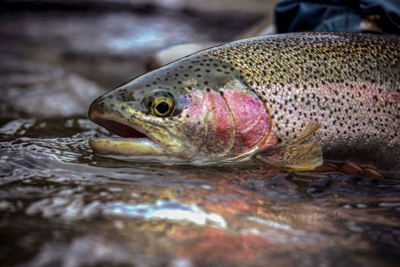 May is always an exciting time for anglers across the state. A time when our attention turns from winter fishing to sun-filled days on the open water.
May is always an exciting time for anglers across the state. A time when our attention turns from winter fishing to sun-filled days on the open water.
Taking a glimpse around at some of the local fishing where I live, and speaking with some fellow anglers, it seems like so far things are off to a productive start. People are getting out, enjoying time on the water with friends and family, and, most importantly, people are bringing fish to their nets.
We have some great content to share in this edition of Reel Times. From chasing coastal cutthroat trout in Prince William Sound, to finding adventure and fish along the Dalton Highway – we’re showcasing some great fishing opportunities.
Have you purchased your 2022 sport fishing license yet? If not, be sure to do so before you head out on your next fishing adventure. Visit our online store to get started.
Are you following us on social media? If not, be sure to check us out on Instagram @wefishak. You can also follow us on Facebook at ADF&G - wefishak . Also, visit our YouTube channel for a growing selection of “how-to” videos and much more.
If you have a comment or story ideas for Reel Times, we encourage you to send them our way. You can send comments to ryan.ragan@alaska.gov.
We’ll see you on the water.
Ryan Ragan
Introducing the New ADF&G Mobile App
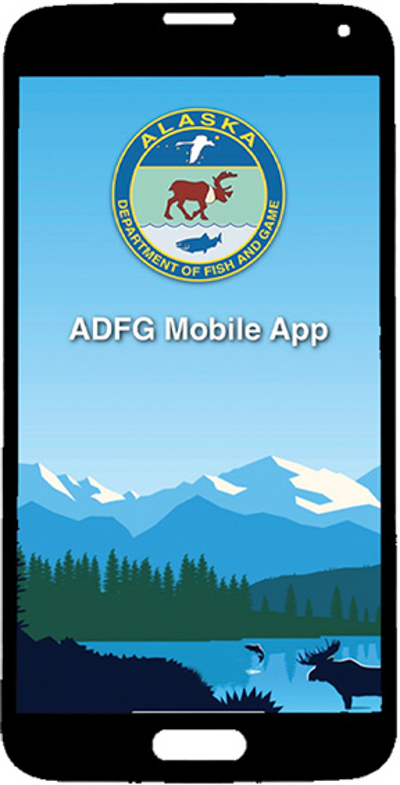 This free mobile app was developed for the people who hunt and fish in Alaska and is designed to enhance your pre-trip planning and in-field experience. The app provides access to the information and services you need to follow applicable hunting and fishing regulations. The mobile app will be available as a free download in the Android and Apple App stores and can be used on a smart device such as iPhone, Android phone, iPad, or Android tablet.
This free mobile app was developed for the people who hunt and fish in Alaska and is designed to enhance your pre-trip planning and in-field experience. The app provides access to the information and services you need to follow applicable hunting and fishing regulations. The mobile app will be available as a free download in the Android and Apple App stores and can be used on a smart device such as iPhone, Android phone, iPad, or Android tablet.
Visit our website to learn more and to download the new ADF&G mobile app to your phone.
Finding Coastal Cutthroat Trout in Southcentral Alaska
 Coastal cutthroat trout (Oncorhynchus clarkii clarkii) are close relatives of the popular rainbow/steelhead trout (Oncorhynchus mykiss) and are related to the five species of Pacific Salmon found in Alaska. Coastal cutthroat trout are identified and known for the red-orange marking along the underside of their gill plate—hence the name “cutthroat” trout. Coastal cutthroat trout can be sea-run or freshwater residents. The sea-run form tend to be brighter and slightly larger than the coastal cutthroat trout that spend their life entire life in freshwater. Freshwater resident coastal cutthroat trout are heavily spotted on most fins, the body below and above the lateral line, and head. The impressive spotting on coastal cutthroat trout will even put “leopard” rainbow trout to shame.
Coastal cutthroat trout (Oncorhynchus clarkii clarkii) are close relatives of the popular rainbow/steelhead trout (Oncorhynchus mykiss) and are related to the five species of Pacific Salmon found in Alaska. Coastal cutthroat trout are identified and known for the red-orange marking along the underside of their gill plate—hence the name “cutthroat” trout. Coastal cutthroat trout can be sea-run or freshwater residents. The sea-run form tend to be brighter and slightly larger than the coastal cutthroat trout that spend their life entire life in freshwater. Freshwater resident coastal cutthroat trout are heavily spotted on most fins, the body below and above the lateral line, and head. The impressive spotting on coastal cutthroat trout will even put “leopard” rainbow trout to shame.
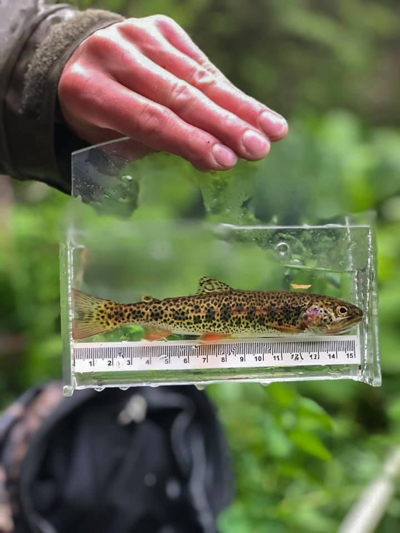 Many southcentral anglers are unaware that there are coastal cutthroat trout in their backyard… well not quite. But if you are an Anchorage resident, a 60-mile drive to Whittier in Prince William Sound and a short boat ride will bring you to the northernmost populations of this beautiful species. For Valdez enthusiasts, coastal cutthroat trout may be even more accessible, with rumors of Coastal Cutthroat trout being caught near town. On the opposite corner of Prince William Sound, Coastal Cutthroat trout are plentiful and can be found in several dozen streams near Cordova. In fact, this eastern portion of the Prince William Sound management area has produced catches of trophy coastal cutthroat trout measuring over 20 inches! Much more is known on the whereabouts of coastal cutthroat trout in Eastern Prince William Sound, especially near Cordova. Unfortunately, there are gaps in the known locations of coastal cutthroat trout in the remainder of Prince William Sound. Alaska Department of Fish &Game (ADF&G), Division of Sportfish and partner Western Native Trout Initiative (WNTI) have initiated a project to fill these gaps using a valuable source of information—sport anglers!
Many southcentral anglers are unaware that there are coastal cutthroat trout in their backyard… well not quite. But if you are an Anchorage resident, a 60-mile drive to Whittier in Prince William Sound and a short boat ride will bring you to the northernmost populations of this beautiful species. For Valdez enthusiasts, coastal cutthroat trout may be even more accessible, with rumors of Coastal Cutthroat trout being caught near town. On the opposite corner of Prince William Sound, Coastal Cutthroat trout are plentiful and can be found in several dozen streams near Cordova. In fact, this eastern portion of the Prince William Sound management area has produced catches of trophy coastal cutthroat trout measuring over 20 inches! Much more is known on the whereabouts of coastal cutthroat trout in Eastern Prince William Sound, especially near Cordova. Unfortunately, there are gaps in the known locations of coastal cutthroat trout in the remainder of Prince William Sound. Alaska Department of Fish &Game (ADF&G), Division of Sportfish and partner Western Native Trout Initiative (WNTI) have initiated a project to fill these gaps using a valuable source of information—sport anglers!
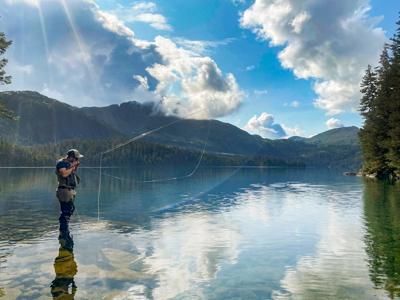 ADF&G and WNTI are encouraging sport anglers to target and share basic information—date, location, size, and photos— about their catches of coastal cutthroat trout in Prince William Sound. Even if the Prince William Sound coastal cutthroat trout was caught years ago or in a stream that is already known to have cutthroat trout, the information will help ADF&G better understand where these fish call home. Already, ADF&G has identified approximately eight new coastal cutthroat trout locations and has leads on many new streams to sample, thanks to anglers like you. If you catch or have caught this native trout species in Prince William Sound, please contact Donald.Arthur@alaska.gov.
ADF&G and WNTI are encouraging sport anglers to target and share basic information—date, location, size, and photos— about their catches of coastal cutthroat trout in Prince William Sound. Even if the Prince William Sound coastal cutthroat trout was caught years ago or in a stream that is already known to have cutthroat trout, the information will help ADF&G better understand where these fish call home. Already, ADF&G has identified approximately eight new coastal cutthroat trout locations and has leads on many new streams to sample, thanks to anglers like you. If you catch or have caught this native trout species in Prince William Sound, please contact Donald.Arthur@alaska.gov.
 Fishing for Prince William Sound coastal cutthroat trout for can provide anglers with a unique opportunity to a catch a new species of freshwater fish in Alaska. Perhaps you may be interested in completing WNTI’s Western Native Trout Challenge, Coastal cutthroat trout from Alaska can be used as a species to complete the challenge. Coastal cutthroat trout fishing in Prince William Sound is a fun activity to do while hiking, berry picking, or while your shrimp pots soak.
Fishing for Prince William Sound coastal cutthroat trout for can provide anglers with a unique opportunity to a catch a new species of freshwater fish in Alaska. Perhaps you may be interested in completing WNTI’s Western Native Trout Challenge, Coastal cutthroat trout from Alaska can be used as a species to complete the challenge. Coastal cutthroat trout fishing in Prince William Sound is a fun activity to do while hiking, berry picking, or while your shrimp pots soak.
Coastal cutthroat trout are aggressive and will strike most flies and spinners. We encourage anglers to check the Prince William Sound sport fishing regulations and utilize best catch-and-release practices. For example, using single hooks and avoiding the use of bait can increase the survival of released Coastal cutthroat trout.
Visit our cutthroat trout species information page to learn more about coastal cutthroat trout.
Interested in finding where coastal cutthroat trout have been documented in PWS? Check out the Anadromous Waters Catalog or the Coastal Cutthroat trout Mapper.
King salmon fishing in the Ninilchik River
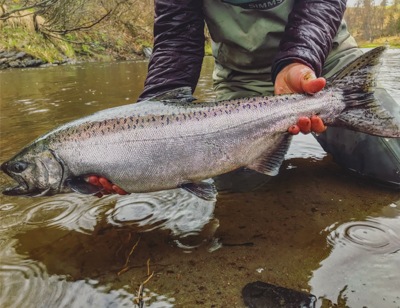 Early-May is a great time to start gearing up for the upcoming summer fishing season and making trip plans so you can squeeze a year’s worth of activities into three short months. One way to stretch the season out a bit longer is to make a shoulder season trip. In Cook Inlet, king salmon are the first salmon run of the season. Fortunately, the locations stocked with king salmon provide anglers a chance to get out fishing for king salmon this year, since the outlook for many wild stocks isn’t great. The Ninilchik River on the lower Kenai Peninsula is a small, road-accessible stream that has been stocked with king salmon annually since the late 1980s and makes a great choice for a Memorial Day weekend camping trip. Alaska State Parks has three campgrounds along the river and this YouTube video highlights the area. For planning a trip and helpful fishing information, check out the newly updated “Fishing on the Lower Kenai Peninsula Roadside Streams” brochure.
Early-May is a great time to start gearing up for the upcoming summer fishing season and making trip plans so you can squeeze a year’s worth of activities into three short months. One way to stretch the season out a bit longer is to make a shoulder season trip. In Cook Inlet, king salmon are the first salmon run of the season. Fortunately, the locations stocked with king salmon provide anglers a chance to get out fishing for king salmon this year, since the outlook for many wild stocks isn’t great. The Ninilchik River on the lower Kenai Peninsula is a small, road-accessible stream that has been stocked with king salmon annually since the late 1980s and makes a great choice for a Memorial Day weekend camping trip. Alaska State Parks has three campgrounds along the river and this YouTube video highlights the area. For planning a trip and helpful fishing information, check out the newly updated “Fishing on the Lower Kenai Peninsula Roadside Streams” brochure.
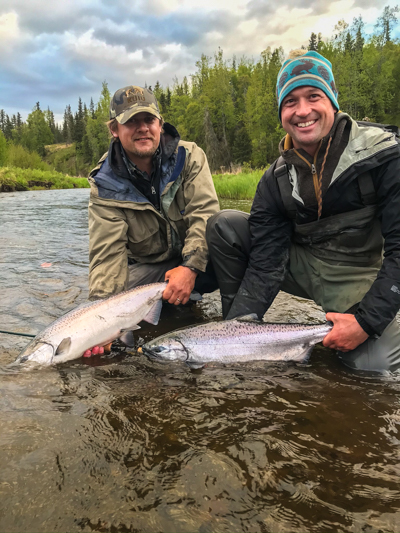 The hatchery king salmon run in the Ninilchik River gets started in mid-May and peaks in early June. The fishing will be better in early to mid-June, but there will be some fresh king salmon in the river to entice anglers at the start of the season. In May, the Ninilchik River will be open on Memorial Day weekend starting Saturday at midnight and goes through Monday. The best fishing will be on Saturday in the early morning hours and in the lower river on the incoming tide. Dead drifting cured salmon roe clusters under a bobber is most effective setup, but spinners, flies and plugs will all catch fish. For those looking for smaller crowds, Sunday and Monday mornings will have fewer anglers. New fish entering the river on each tide will provide some fresh kings to target on those mornings, too. The daily counts of wild and hatchery king salmon in the Ninilchik River are posted on the Sport Fish web counts page, which is the best way to know how many are moving through the river. The Ninilchik River (Mile 2) fish counts are from the weir closest to the sport fishery area.
The hatchery king salmon run in the Ninilchik River gets started in mid-May and peaks in early June. The fishing will be better in early to mid-June, but there will be some fresh king salmon in the river to entice anglers at the start of the season. In May, the Ninilchik River will be open on Memorial Day weekend starting Saturday at midnight and goes through Monday. The best fishing will be on Saturday in the early morning hours and in the lower river on the incoming tide. Dead drifting cured salmon roe clusters under a bobber is most effective setup, but spinners, flies and plugs will all catch fish. For those looking for smaller crowds, Sunday and Monday mornings will have fewer anglers. New fish entering the river on each tide will provide some fresh kings to target on those mornings, too. The daily counts of wild and hatchery king salmon in the Ninilchik River are posted on the Sport Fish web counts page, which is the best way to know how many are moving through the river. The Ninilchik River (Mile 2) fish counts are from the weir closest to the sport fishery area.
For fishing for king salmon in the Ninilchik River, you’ll want a medium action rod with approximately 20 lb. test, or an 8 wt. fly rod. If you’re fishing with cured salmon roe, use an egg loop leader on a 4/0 hook under a slip bobber. Don’t forget your gear is restricted to single-hook only, and if you catch a wild king salmon (adipose fin intact) be ready with your pliers to release it without removing it from the water.
For those looking for more to do on the lower Kenai Peninsula over Memorial Day weekend, consider taking a fishing charter for halibut in Cook Inlet, or even a day charter over to Polly Creek for razor clams. For a cheaper fishing option, surf fishing for halibut and other groundfish is becoming more popular in the area. Down in Homer, the first few kings will be trickling into the Nick Dudiak Fishing Lagoon (The Fishing Hole) on the Homer Spit.
How Does ADFG Collect Sport Fishing Data in Southeast Alaska?
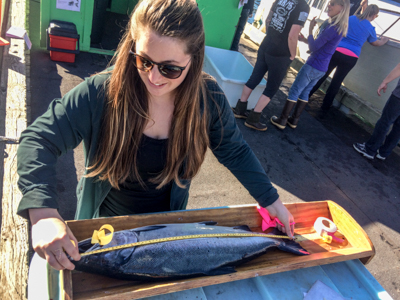 Have you ever wondered how the Alaska Department of Fish and Game, Division of Sport Fish estimates harvest of salmon and groundfish in Southeast Alaska? Without an unlimited budget or access to sample all harvested fish, how do we know what was harvested? Well, in Southeast Alaska, data is collected through multiple programs that are combined and used to produce statistically defensible estimates of the harvest. In addition to providing information crucial for the management of state fishery resources, the data collected is also used for federal and international obligations such as the Pacific Salmon Commission, International Pacific Halibut Commission, and the North Pacific Fisheries Management Council.
Have you ever wondered how the Alaska Department of Fish and Game, Division of Sport Fish estimates harvest of salmon and groundfish in Southeast Alaska? Without an unlimited budget or access to sample all harvested fish, how do we know what was harvested? Well, in Southeast Alaska, data is collected through multiple programs that are combined and used to produce statistically defensible estimates of the harvest. In addition to providing information crucial for the management of state fishery resources, the data collected is also used for federal and international obligations such as the Pacific Salmon Commission, International Pacific Halibut Commission, and the North Pacific Fisheries Management Council.
If you’ve done any recreational marine boat fishing in Southeast Alaska, chances are you have encountered a Fish and Wildlife Technician asking you about your trip. These technicians are referred to as Creel Samplers, and the Marine Harvest Studies program is one of three programs used by the Division to make harvest estimates. Creel samplers are stationed at docks and harbors throughout Southeast Alaska within nine communities, from Yakutat in the north to Ketchikan in the south.
The second program is the Alaska Sport Fishing Survey, known by many as the Statewide Harvest Survey. This is a questionnaire mailed to about 50,000 randomly selected households who held an Alaskan sport fishing license that year. The third is the Charter eLogbook Program.
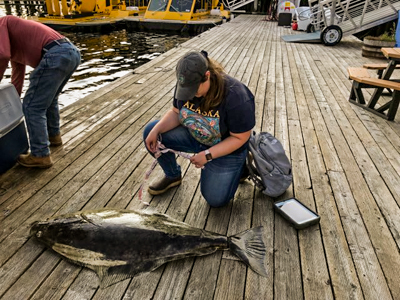 In Southeast Alaska, the Charter eLogbook program requires an electronic logbook to be filled out for every guided trip. These three independent sampling programs are used individually or together to generate estimates of sport fishery harvest and other related metrics of catch and effort.
In Southeast Alaska, the Charter eLogbook program requires an electronic logbook to be filled out for every guided trip. These three independent sampling programs are used individually or together to generate estimates of sport fishery harvest and other related metrics of catch and effort.
When Creel Samplers collect data from your harvest, they are filling a huge information gap because the Marine Harvest Studies is the only program where we can physically observe the fish retained by anglers of all sport sectors (charter, private, resident, nonresident). This allows the Division to collect information on individual rockfish species, estimate average weights of bottom fish, get individual fish size, age, and genetics as well as recover coded-wire tags from king and coho salmon to help identify their origin. Creel information from the Marine Harvest Studies along with Charter eLogbook data is used to provide an inseason overview of the sport fishery.
Whether you have been interviewed after sport fishing or been sent an Alaska Sport Fishing Survey, your willingness to participate in these programs is key to the management and sustainability of Alaska’s sport fisheries. So, next time you are asked to contribute to our data collection process, remember that your fishing trip and catch information play an important role in managing Alaska’s most unique and important resource.
Summer Sport Fishing Highlights Along the Dalton Highway
A road trip along the Dalton Highway affords good opportunities for sport fishing at stream crossings while exploring the Arctic. The best fishing opportunities are between July and mid-September as many streams are turbid from snowmelt runoff throughout much of June. Because much of the Dalton Highway extends beyond the Arctic Circle, inclement weather including snow can be present at any time during the summer, particularly late August and September.
The Dalton Highway, also known as the Haul Road, is a rough, industrial road that begins 84 miles north of Fairbanks off of the Elliott Highway and extends for 414 miles to Deadhorse, the industrial camp at the Prudhoe Bay oil fields. A trip up the Dalton Highway requires planning and preparation as services are limited and there are few amenities. Gas is available at the Yukon Crossing (Mile 56), Coldfoot (mile 175), and Deadhorse (mile 414). There are no medical facilities, grocery stores, banks, cell phone coverage, or grocery stores. Towing services are available in Fairbanks, Coldfoot, and Deadhorse and towing these distances can be pricy, therefore make sure you have good tires and a spare or two and that your car is in good working order. Be sure to bring good rain gear, warm clothes, food and ample water, and insect repellent and/or head net as the mosquitoes can be bad during the summer! Big trucks service Prudhoe Bay and have the right of way. More information about travelling the Dalton Highway including points of interest can be found in the Dalton Highway Visitor Guide.
Here some of the more popular fishing locations along the first 157 miles of the Dalton Highway along with a few cool sights that can be explored in between fishing stops.
Mile 24: Hess Creek
This is the largest stream between the Elliott Highway and the Yukon River Bridge.
Mile 56: Yukon River
Except for burbot fishing during the winter (see February 2021 Reel Times article), essentially no sport fishing occurs on the mainstem Yukon River because of water turbidity and casting from shore across a mile-wide river makes it feel even more futile. Most fishers use the boat launch that is just east of the Dalton Highway bridge to access clearwater tributaries such as the Dall River that is 24 miles upstream for Northern pike and the Ray River that is 2 miles downstream for salmon.
Mile 98: Finger Mountain Wayside
Beautiful panoramic views, half-mile interpretative trail, and pit toilets at this rest stop.
Mile 107: Kanuti River
A large turnout is located on the southeast side of the bridge. Near the bridge Northern pike and Arctic grayling can be found. There is a small boat launch and a small canoe or pack raft can be walked upstream while fishing, and then float back downstream. The reverse can also be done for experienced floaters as there will be sweepers and a canyon with rapids in addition to the need to hike back to the road crossing.
Mile 115: Fish Creek
A small creek with good fishing for Arctic grayling. Near here is the Arctic Circle Wayside with a viewing deck, interpretative displays, pit toilets, and a primitive campground.
Miles 123 and 124: South and North Forks Bonanza Creek
Another good stream to target Arctic grayling.
Mile 135: Prospect Creek
Good fishing for Arctic grayling and Northern pike.
Miles 140, 141, and 144: Jim River
The Jim River is a lovely clear-water river that is good for Arctic grayling fishing. Bonanza and Prospect Creeks are tributaries of the Jim River. The Dalton Highway follows the Jim River for approximately 10 miles and crosses this river three times. Fishers can fish and float in between the bridges.
More information on these fishing locations as well as additional ones at and above Coldfoot can be found in the Sport fishing Along the Dalton Highway brochure. Always have a current sport fishing license and copy of the current regulations before you go fishing. Most fish caught are Northern pike and Arctic grayling, although many of these streams also have harder to catch whitefish. Please be aware that salmon fishing is CLOSED within a 5-mile radius of either side of the Dalton Highway. The Northern pike limit is 5 per day, 5 in possession, only 1 of which may be 30 inches or longer. Arctic grayling are limited to 5 per day, 5 in possession with no size limit. As visual predators, both Northern pike and Arctic grayling like flashy, shiny lures like shiny spoons and jigs for the smaller streams. Northern pike will also strike shads that resemble smaller and juvenile fish, including those that resemble juvenile pike!
In the sub-Arctic and Arctic fish tend to grow and reproduce more slowly and these populations are particular susceptible to overharvest and size and abundance can rapidly decrease with fishing pressure compared to streams in lower latitudes. So please practice proper catch-and-release techniques, including using single, barbless hooks, using a soft landing net, and keeping the fish in the water for photographs.
Field to Plate - Recipe of the month
Recipe of the Month – Slow-Roasted Alaska Halibut with Citrus & Smashed Olives and Halibut Ceviche
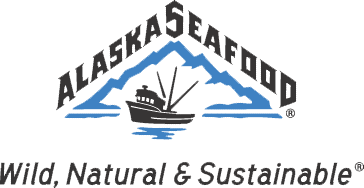 Try this great recipe for Slow Roasted Alaska Halibut with Citrus Smashed Olives from the Alaska Seafood Marketing Institute.
Try this great recipe for Slow Roasted Alaska Halibut with Citrus Smashed Olives from the Alaska Seafood Marketing Institute.
Or, try this great recipe for Halibut Ceviche from the Alaska Department of Fish and Game.
Enjoy!
If you have any questions about the Reel Times newsletter, please contact Ryan Ragan at ryan.ragan@alaska.gov
